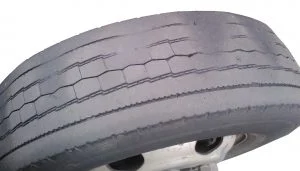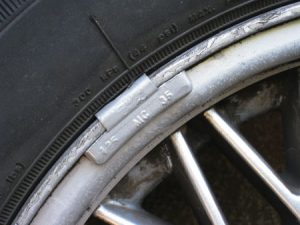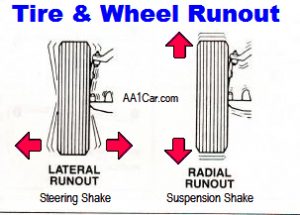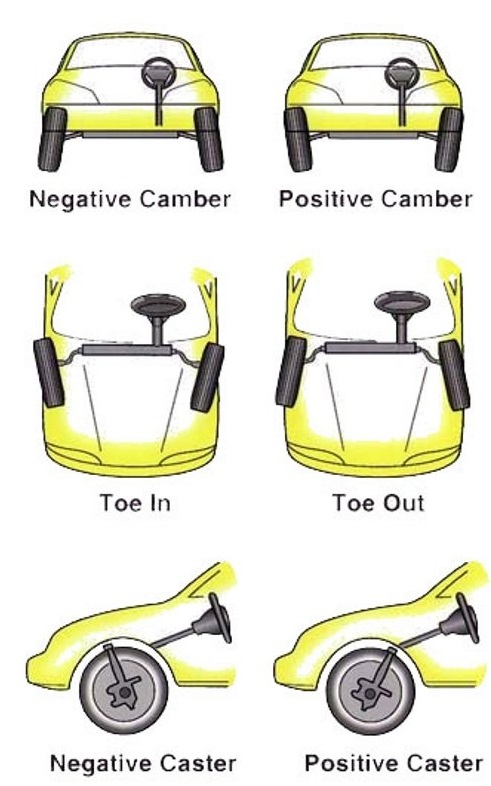Should I Change A Tire If Cupping Is Light
Cupped tires are usually a sign of:
- Loose, worn, or aptitude shock absorbers/suspension parts.
- Unbalanced or runout tires.
- Misaligned wheels.
- Poor-quality tires.

The most noticeable signs of cupped tires are a scalloped treadwear pattern and noise. The tread looks like it was scooped in 3- to 4-inch bits all across the tire, in the middle, or on the edge. This is a outcome of the cycle bouncing, which means the tire doesn't bear on the surface evenly. The noise of cupped tires is growling or grinding, very similar to that of a bad wheel bearing. Information technology'southward important to be able to distinguish the sounds. The noise generated by cupped tires will increase as you lot speed up. The bike begetting noise will alter forth with the direction of the part. For example, if y'all hear the audio or changes in the audio when turning left, your driver'due south side wheel bearing may need attention.
Master Reasons of Cupped Tires
Loose, Worn, Bent Shocks or Intermission Parts
Shock absorbers and the car's intermission are the primal elements that allow the auto to ride smoothly. When any pocket-size role of that system is bent or worn, it becomes loose, assuasive the wheel to bounce. Aside from a bumpy ride, such an upshot also causes cupped tires. Daze absorbers have to be replaced every fifty,000-60,000 miles, struts every 60,000-90,000 miles. Pause bushings have a longer lifespan – 100,000-150,000 miles. Therefore, to avoid cupped tires, make sure you lot audit the parts at least once a year (or every 12,000 miles). Shocks are often neglected by drivers – but well-nigh 1 in 5 thinks their maintenance can improve handling. A survey by a large shocks manufacturer showed that 70% of drivers recall shocks are a minor auto function responsible only for ride comfort. However, the Cologne Plant for Traffic Rubber (Switzerland) proved the importance of adept shock absorbers. The inquiry team found out that as the parts' dampening ability descends to 50%, information technology takes a car 23% more than distance to terminate. For case, it's near 21 feet at 31 mph, which is a long braking distance. Besides shocks, there are many more parts that may too get the reason for cupped tires. Problems with these parts aren't as frequent, but brand sure to bank check brawl joints, bushings, springs, wheel bearings, etc. Any function that connects the bicycle to the rest of the vehicle may be the culprit.
Tire Imbalance or Runout
Tire Imbalance
A tire is out of balance when the weight across its circumference is irregular. The main consequence is vibration at 45 mph, which increases with speed. The bike bounces, assuasive the tire to lose grip of the road for short periods of time. With every rotation, such bouncing creates scoops of rubber on the tire, causing cupped tires. This particular type of article of clothing is too called patch wear, equally the scoops may be not every bit regular as those caused by a failing suspension.

If tire imbalance is the only reason for tire cupping in your instance, go to a tire shop to get your tires balanced. A technician volition put pocket-size weights opposite the stiffer spots, diagnosing the tires beforehand. Information technology volition cost y'all $ten-$xv per wheel if there are no other bug. You can observe nigh of the trusted tire shops here. Fifty-fifty an imbalance of 0.25 of an ounce may cause cupped tires, so neglecting this cistron may pb to deterioration in treatment. Besides, yous may prolong your tire life past as much as twenty% if balancing them in time. If yous desire to learn more about tire imbalance and possible solutions, read this commodity.
Tire Runout

Runout is a term that ways not a perfectly round shape of a tire, wheel, or rim. There are ii types:
- Lateral – side-to-side flaw that causes wobbling.
- Radial – imperfection between the high and depression spots (or average line).
To some extent, runout is adequate, simply when the lateral increases to .08" and/or the radial increases to .06", information technology becomes a trouble. Due to abiding wobbling and/or shaking, the tire loses grip with the road, which leads to cupped tires.
Wheel Misalignment

Misaligned wheels are not perpendicular to the road and/or not parallel to each other. The alignment consists of three angles:
- Camber. This angle puts the wheels in a perfectly perpendicular position to the route surface. The platonic setting is camber 0, as when it goes negative or positive, tires may article of clothing unevenly and suspension may fail prematurely.
- Caster. This bending is responsible for the position of the steering axis to the route. The perfect setting is pulley 0, as a positive or negative position may make information technology hard to keep the vehicle in a straight line and turn.
- Toe. When this angle is 0, the wheels are perfectly parallel to each other. It'due south the most of import for even tire wear as if the setting is in or out, rubber will be wearing more on one side, often leading to cupped tires.
Misalignment is often responsible for back tire cupping, particularly if the rear and front tires aren't parallel to each other. Every bit the procedure is performed on the suspension, y'all should go on checking it every time you install a new part. However, such checks are necessary every 6-12 months fifty-fifty if you don't supercede whatever of the suspension parts.
Low Quality Tires
Inexpensive tires of poor quality or imitation tires will most probably cup with any minor vibration or bounciness. They are thinner and the rubber compounds in them are not every bit temperature- and stress-resistant. Such tires may be heavily imbalanced or runout, and they will age and crack much earlier. If you somehow have such tires and notice premature keen, cupped tire wear, or unnatural colour of sidewalls, supersede the tires as shortly as possible. Brand sure you choose new tires carefully and buy only from authorized dealerships or shops.
Identifying Cupped Tires
You can identify the consequence and its possible reasons by:
- Noticing vibration and wobbly beliefs, specially when hit a road obstacle. This means one or more tires are cupping.
- Noticing the vehicle leaning to i side as well much when turning. This volition hateful the tires demand balance.
- Letting the car tedious down past itself without braking. The motorcar leaning to one side of the road will hateful imbalance.
- Pressing the hood of the car downwardly and looking for bouncing motions. If you stop applying pressure, just the bounce is yet there, the interruption or struts may exist loose, worn, or aptitude.
- Inspecting the tires themselves by running your hands across the tread. Some cupping may not be visible at first, but if you feel whatever wavy surface, that would be a sign of it.
Past detecting and fixing the issue in time, you relieve your tires and pause, improving comfort and safety.
Fixing the Issue
The best a driver tin do to fix the issue is diagnose the tire-wheel assemblies and detect the crusade of cupping. Drive your automobile to a repair store where a technician volition cheque your suspension, wheels, and tires. If a replacement is necessary, do information technology as soon as possible, including buying new tires if the specialist suggests doing so. If no new tires are needed, make sure you rotate and rebalance them after all necessary part replacements. Rotation volition help the existing uneven vesture smooth out and avoid uneven patterns in the futurity. Balancing will assist get the weight distribution in the tire correct, as cupping may accept changed information technology. In case whatever of the suspension parts need replacement, brand sure to align the wheels afterward.
Vehicle and Tire Maintenance to Prevent Cupping
The necessary procedures to avert tire cupping are:
- Balancing.
- Rotating.
- Wheel alignment.
- Pressure check.
- Ownership new tires in time.
Information technology's crucial to check tire balancing every 3,000-six,000 miles, as weight distribution within the tires changes every bit they vesture. Yous should also rotate the tires every five,000-8,000 miles to avoid uneven habiliment and prolong tire life. Wheel alignment is vital for preventing cupped tires and other problems. The suspension condition has to be checked every year, followed by an alignment if necessary. Also, you should cheque tire pressure level every calendar month to make certain the aggrandizement rate is stable and none of the tires loses more air than it should. Severe underinflation may sometimes crusade cupping in the middle of the tire. It's too important to remember that tires older than 5-6 years need full annual diagnosis. Also, tires that accomplish 2/32" depth, even if only in the scoops in the case of cupped habiliment, should be replaced. At that point they are considered dangerous, then don't wait until they smooth out.
FAQ on Cupped Tires
Q: Can I Drive on Cupped Tires?
It's acceptable to drive on them if the overall condition of the tires is good. Higher spots will wearable faster than lower spots, which will smooth them out somewhen. If the scoops are as deep as 2/32", though, the tires are no longer fit for utilise. (2/32" is the legal minimum tread depth for tires.) If yous choose to smooth the tires out by driving, call back that the ride may be dangerous, especially on wet surfaces.
Q: Why Is It Unsafe to Bulldoze if I Have a Cupped Tire?
Because the tire loses grip due to uneven contact with the surface, which may lead to control loss. Also, the vibrations and noise that information technology generates may harm other sensitive wheel parts and fifty-fifty cause nausea to the driver or the passengers.
Q: Why Do My Tires Cup on the Inside?
Tires cup on the inside due to severe suspension issues. More rarely, such a pattern is caused by bad wheel bearings, loose ball joints, damaged control arm or steering linkage. You lot demand to become to a repair store and run a full diagnosis on the suspension and other parts that connect the wheel to the car.
Q: Why Practise My Tires Loving cup on the Outside?
If the wear is shut to the outside border, this may also hateful a damaged suspension. However, if the pattern is between the outside edge and the middle of the tire, the main reason might be tire imbalance. In case at that place are many hills and valleys, shock absorbers or struts may be the culprit.
Q: Why Do My Tires Cup in the Eye?
Middle cupping is usually a result of astringent underinflation, failing shock absorbers or cycle bearings, tire imbalance, or damaged suspension. Underinflation-related cupping is rare and has noticeable characteristics. The scallops are frequent and pocket-size, dissimilar the shocks-related pattern that has larger scoops. Damaged cycle bearings usually cause small just deep scallops.
Q: Why Exercise My Back Tires Cup?
Back tires commonly scallop due to poor bike alignment. As well, if those tires are on a truck or a trailer, the loads may utilize more pressure to ane of the tires, causing the issue.
Maintenance is the Key to Avoiding Cupped Tires
When trying to avoid issues with tires, drivers usually put their efforts to maintaining the safety. However, the roots of the problems may lie in the vehicle, and failure to notice that may crusade serious consequences. Some tire blowouts are acquired by neglected tire scalloping, which is in turn caused by neglecting interruption, shocks, struts, etc. Learn about the lifespan of the parts that connect the wheels and the vehicle and supercede them when necessary. Find out what are the symptoms of a particular role's failure and look for them when cupping occurs. Pay enough attention to bones maintenance procedures. If you do all that, tire cupping won't exist a problem for you.
Source: https://www.utires.com/articles/cupped-tires-reasons-repair-prevention-faq/
Posted by: michealswoned1969.blogspot.com


0 Response to "Should I Change A Tire If Cupping Is Light"
Post a Comment